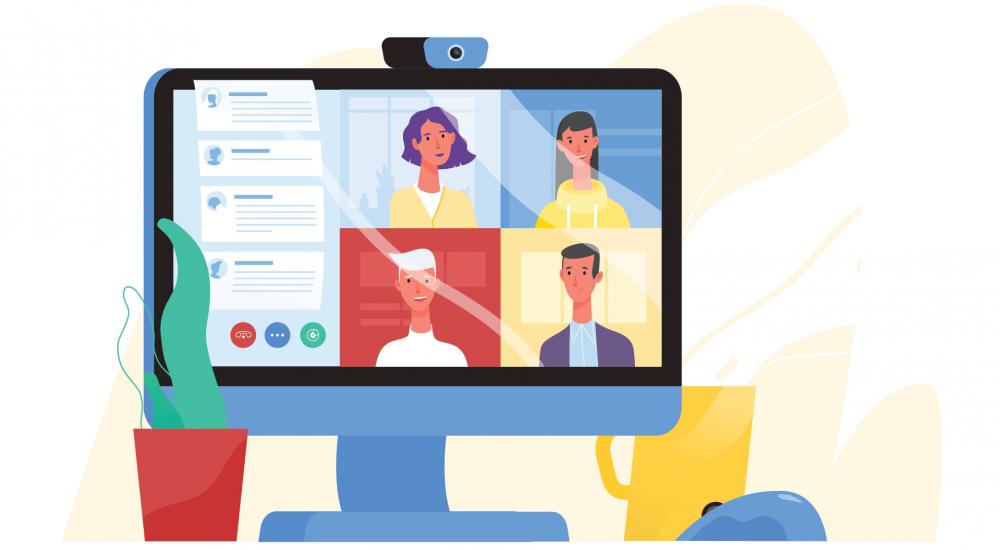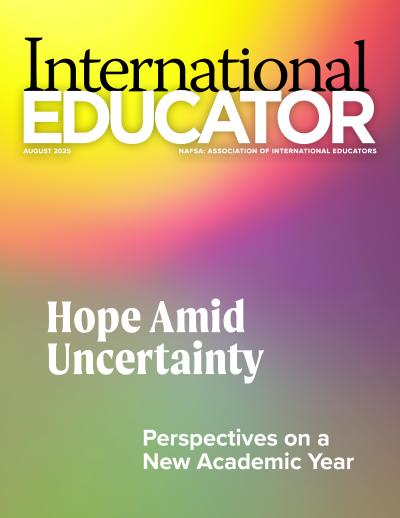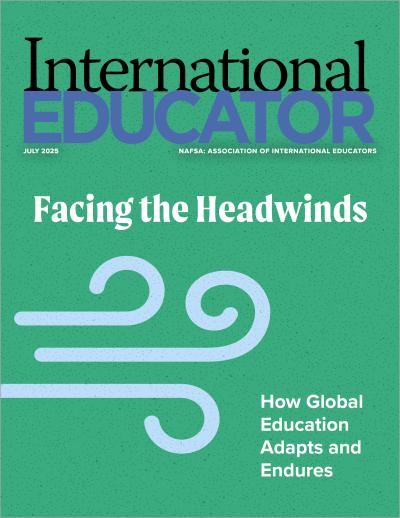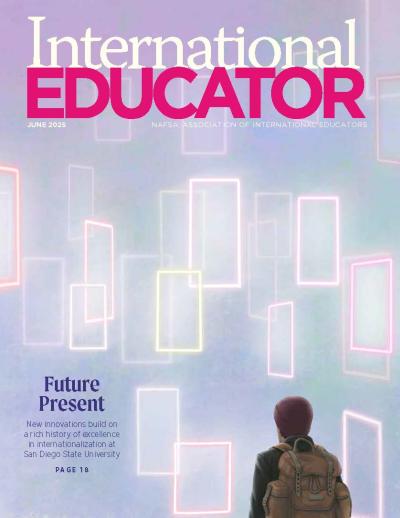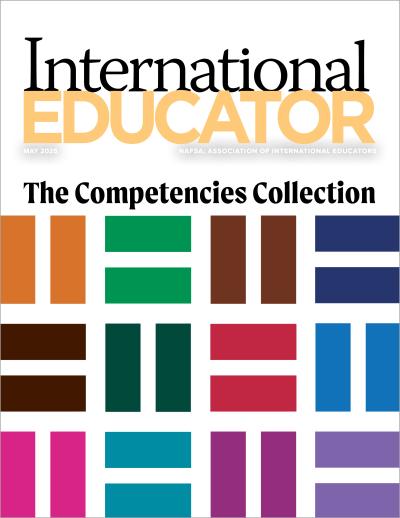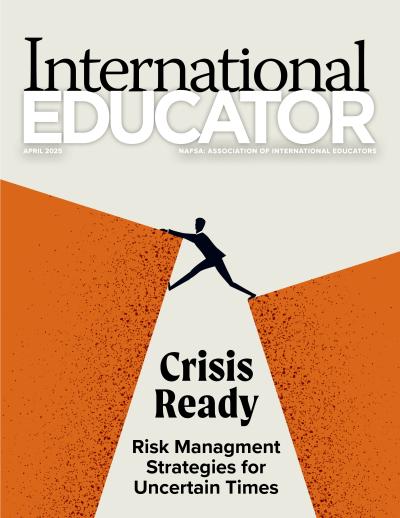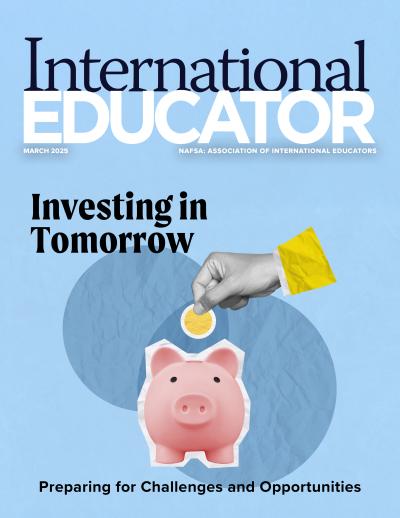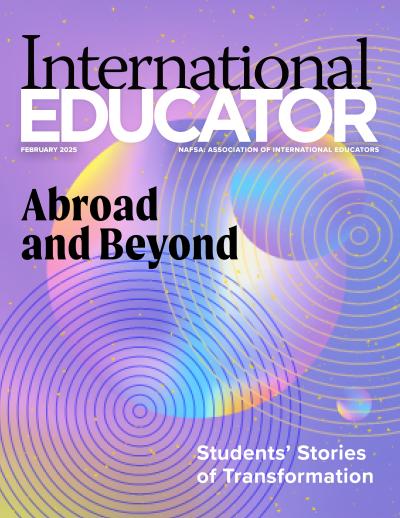The Millennial Manager

When she first took on a leadership role in the University of Vermont’s Office of International Education, Director Emma Swift stuck a note card with three words written on it to her bulletin board: “Meaning, membership, and mastery.”
Known as the “three M’s” of motivating professionals in the workforce, these concepts also represent the characteristics of many Millennials in the workplace—a purpose-driven mindset, a desire to be seen as a whole person, a comfort with technology, and an insistence on work-life balance.
The youngest Millennials are now approaching 30, with “elder Millennials” already a few years into their 40s. As they, like Swift, enter leadership roles in international offices and elsewhere, another dynamic is coming into play: Millennial leaders must navigate the preferences of younger, Gen Z employees as well as those from earlier generations, including Gen Xers and Baby Boomers.
“I see Millennial managers as a bridge between the old way of thinking and the new,” says Caroline Cully Garbers, associate director of education abroad at the Georgia Institute of Technology. “When you are that bridge, you have to advocate for both sides of the perspectives of how an office should work.”
‘The Middle Kid’
Sandwiched between Generations X and Z, Millennials are typically defined as people born between 1981 and 1996. By most counts, they now make up more than one-third of the U.S. workforce—and more than half are now in managerial roles. A 2020 Harris Poll survey conducted for Zapier, for example, found that 62 percent of Millennials have direct reports.
As Millennials have entered and advanced in the workforce since the early to mid-2000s, much has been written about their impact, not all of which is complimentary. Their positive traits—empathy, work-life balance, belonging—can come across as impatience, an overdependency on feedback, and unrealistic expectations about flexibility. Generational conflicts have been evident in the current postpandemic battles over remote work, an issue that has, at times, been particularly challenging for international offices trying to staff student-facing positions.
“They intuitively have a better understanding of the needs of their workers and work-life balance.” —Charter Morris
But what’s becoming clear is that Millennial leaders play a crucial role in multigenerational workplaces at a time when five distinct generations are of working age.
“They’re kind of the middle kid. They’re bridging the divide between older ways of doing things and the new ways,” says Charter Morris, director of international student and scholar services at the University of Alabama, who identifies as a Gen X leader. “They intuitively have a better understanding of the needs of their workers and work-life balance.”
The small size of many international offices or units contributes to cultivating the sense of belonging that Millennials and Gen Zers crave. Many Millennial managers focus on recognizing both the work and personal lives of coworkers and seek to create “psychological safety” for their colleagues, as Swift puts it. But that can bring extra weight and responsibility, turning Millennials into so-called “momagers”—or a parent and a manager, a dual role that’s neither appropriate nor sustainable.
“I love my coworkers—they’re truly my favorite people,” says Swift. “Because of that, it can make the lines inherently a bit blurry.”
Advice for Leaders
Regardless of generation, leadership is difficult, and many managers learn primarily through their experiences and those of peers. “There’s not a handbook. You have to figure things out for yourself,” says Caylie Middleton, who formerly worked at the University of Vermont and is now U.S. director of sales and engagement for affiliate institutions at ISEP.
Among the advice offered by leaders in international offices:
Remember that one size doesn’t fit all.
While being aware of generational characteristics is helpful in navigating the dynamics of intergenerational teams, “there are many people who buck these trends,” Swift says. “I don’t identify strongly as a Millennial.”
That’s particularly true in international offices, where both employees and the students they serve come from different backgrounds and around the globe. “The understanding of what is Millennial and [what is] Gen Z is rooted in American concepts,” says Morris. With half of his colleagues born outside of the United States, he argues that people’s workplace attitudes tend to be more influenced by the norms of their country of origin than their age.
“When you add in international dynamics and intercultural communication frameworks, some of this stuff gets more nuanced,” Middleton agrees.
Be aware of generational differences.
Multiple generations often work together on the same teams, raising a challenge for leaders of any age: managing staff older or younger than they are. Millennial leaders “seem to have a knack for that,” Morris says.
“My main goal as a manager is to support my team in any way possible,” says Cully Garbers. “Some managers say everyone should be treated the same and do the work the same way. But support looks different for every person.”
However, an additional challenge is that, over time, attrition and retirements can lead to a situation where most people in a given workplace are closer in age. “When an office has drifted towards lots of people of a certain generation, how do we make sure those who aren’t [in that generation] feel included in the membership of the team?” Swift asks.
“My main goal as a manager is to support my team in any way possible. ... But support looks different for every person.” —Caroline Cully Garbers
Leaders of multigenerational teams note that communication and technology adoption and use can be potent conflict points. The telephone is an exemplar of those issues; Gen Xers and Boomers may overly gravitate toward its use, while Gen Zers (and even Millennials) may underestimate its usefulness in contacting students and colleagues. The end goal, Cully Garbers says, is to find the right medium “for the outcome we’re looking for.”
Manage up—and down.
A challenge for all leaders, communication can be particularly difficult for Millennial leaders whose desire to be open with their staff may conflict with the more cautious communication preferences of more senior leaders—caution that is often born from experience.
“It’s very easy to get into a lot of trouble without some sort of filter one way or another,” says Morris. His advice is to have conversations with senior leaders about how much they can safely divulge about sensitive issues. At the same time, Millennials’ desire for transparency can also help leaders from other generations.
“I have taken a page out of my Millennial counterparts’ book about this with [getting] more buy-in and listening to everyone’s opinions,” Morris says.
Address work-life balance.
To support a growing Millennial and Gen Z workplace, managers must strike a balance between the responsibilities of the job and the desire for flexibility. “International educators do really important work—we facilitate opportunities that are life changing,” Swift says. “There are situations that are time sensitive and everything has to drop, but we shouldn’t do work at the expense of existing.”
A good way of promoting healthy work-life balance is celebrating within the office. Swift recalls mustering her office to do a Gen Z-friendly TikTok dance at the request of a staffer celebrating his birthday. “That’s not my generation,” she says, “but it cultivates a sense of membership and joy and fun.”
“There are situations that are time sensitive and everything has to drop, but we shouldn’t do work at the expense of existing.” —Emma Swift
Managers should clearly identify nonnegotiable aspects of the job—for example, working on premises in August when students arrive and availability for evening or early-morning calls. “Our world is a little bit different, because when working in international settings, time zones are a thing,” Cully Garbers says. “Sometimes we’re asking people to work past 5:00 p.m. because of the nature of the field, but we’re not going to ask them to work 60 hours a week to get the job done.”
At the same time, younger leaders—and staff—sometimes need to be reminded of the value of professional learning and conferences, which are beyond their stated work responsibilities but an essential part of building a career, according to Morris. “That’s inherently understood by [Gen] Xers and Boomers,” he says. He shares how involvement in NAFSA advanced his career and notes the importance of staying up to date with the field.
This has the added benefit of creating support for newer leaders, who may feel alone in their position. “It’s lonely. No one prepares you for that,” Middleton says. Leaders should seek peers who can form a support network, whether on campus or through networks like NAFSA’s.
Set boundaries.
Millennials’ emphasis on knowing their colleagues is “indicative of better communication, more empathy, and trust,” Middleton says. At the same time, it can also “blur the line of what are appropriate dynamics for a boss versus appropriate dynamics for a friend,” she adds. “Sometimes that can get heavy as a manager.”
Leaders can model appropriate boundaries, Swift says. “One way I think about that balance is really framing for myself and the people I lead that… we need to ensure we also feel richness in our lives outside of international education, and the only way to do so is not to fall victim to the trap of our whole identity being tied up in the work,” she notes.
“A lot of folks in international education tend to work hard and derive a lot of meaning from their work. That’s great, but it’s a recipe for making your work [your] life.” —Caylie Middleton
When leaders learn about colleagues’ personal challenges, they must identify what their institution can—and can’t—do in terms of support. “No matter what, I’ll listen,” Middleton says. “It’s important to listen, but stick to identifying areas of work that might be impacted and areas of support where, from my position as a supervisor, I can help.”
The deeper connections Millennial managers foster can increase the risk of burnout. “A lot of folks in international education tend to work hard and derive a lot of meaning from their work,” Middleton says. “That’s great, but it’s a recipe for making your work [your] life.” Setting personal boundaries not only helps but also sets a good example for staff.
“I’m deeply invested in my people being successful, happy, and healthy in their lives,” says Swift. “I’m making space and giving grace that all of us are dealing with things that are going to show up in our workplaces, [but] we all need to build skills in managing those things.”
Hold people accountable.
Hard conversations are challenging for every manager, but Millennial leaders have, rightly or wrongly, been criticized for avoiding them. As a Gen X leader, Morris focuses on “having conversations about having tough conversations” with his counterparts. “I tell them, ‘This is how I would approach it, and tell them to “take that and adapt it however you want,” but, ultimately, this is what we have to impart,” he says.
‘In Good Hands’
To address these challenges they face as leaders, Millennials should emphasize career progression and support professional growth—both for themselves and their staffs, Swift says. “Any leadership role is about both leading a group of people and leading an evolving workplace as well as nurturing teams into leadership positions themselves. We set each other up for success by trying to build skills,” she says.
They should also keep in mind that the most acute generation gap may not be among colleagues but with the students they serve. “We’re all working with college students who stay the same age in perpetuity,” Swift says. “They continue to be of new generations, they evolve, and they’re increasingly younger than us.”
While leadership skills take time to develop for any generation, international educators believe that Millennials have a toolkit that can bridge the needs of current students and colleagues of all ages. “I think we’re in really good hands,” Morris says. •
NAFSA Resources
About International Educator
International Educator is NAFSA’s flagship publication and has been published continually since 1990. As a record of the association and the field of international education, IE includes articles on a variety of topics, trends, and issues facing NAFSA members and their work.
From in-depth features to interviews with thought leaders and columns tailored to NAFSA’s knowledge communities, IE provides must-read context and analysis to those working around the globe to advance international education and exchange.
About NAFSA
NAFSA: Association of International Educators is the world's largest nonprofit association dedicated to international education and exchange. NAFSA serves the needs of more than 10,000 members and international educators worldwide at more than 3,500 institutions, in over 150 countries.
NAFSA membership provides you with unmatched access to best-in-class programs, critical updates, and resources to professionalize your practice. Members gain unrivaled opportunities to partner with experienced international education leaders.




